
Rover Location Database
Travel
- Travel
- April '23 CN76
- Sept '22 CN76
- May '22 CN93
- Feb '22 CN93
- Jan VHF '22
- Dec '21 CN78
- Aug '21 CN76
- July '21 CN78
- May '21 Ely, NV
- July '20 CN98
- June '20 DN08
- June '20 N7G
- July '19 DN27-07
- Sept '18 CN98
- June '18 DN08
- June '18 DN22-43
- June '18 EN02
- June '18 Article
- June '18 EM87
- Summer '17
- Sept '16 CN87
- Apr '14 CN82-92
- Mar '14 Plan
- Jan VHF '14
- Jan '13
- Oct '12
- May '12
- Jan VHF '12
- Sept '11
- June '11
- May '11
- April '11 CN97
- March '11 CN97
CN76 for Lloyd N9LB
Sept 6-9, 2022
Here's my trip report from activating CN76 in the hopes of working Lloyd N9LB for his last FFMA grid.
September is very late in the season for E-skip and we didn't seriously expect ionospheric propagation to help us make a 1710-mile contact. So we planned two approaches.
- First, I dedicated as much time as possible on site, four days, Sept 6-9, in case we got lucky with propagation.
- Second, we planned EME for two nights when moon conditions were favorable.

Moonbounce
Although neither Lloyd nor I have used EME very much, Lloyd has an extremely capable friend with a good EME station to help, John W9JN (FFMA #21).
The operating plan was a little complicated: Lloyd would operate John's station remotely while they kept in touch by telephone, and meanwhile I kept in touch via Slack.
I've tried EME once before and found that my IC-7300's receive sensitivity is not sufficient, so I bought and built a Mini-Kits preamp from Australia for this trip. It is rf-switched and goes between my IC-7300 and my KW amplifier; typical drive levels are 20-30w in this stage, so it should be happy with T/R rf-switching. It tested out very well during a week of dry runs in my driveway.
My mast is only vertical and I can't tilt my 6m5 upward, so the EME contact would be on my moonrise, while Lloyd and John would elevate by 20-30 degrees.
Grayland Beach CN76ws to Lloyd N9LB EN52hv: via E-skip = 1,710 miles
Grayland Beach CN76ws to Lloyd N9LB EN52hv: via EME = 440,000 miles
Choosing an operating frequency for EME:
- Typically between 50.180 and 50.200 MHz
- Coordinate frequency with your scheduled partner
- Avoid 50.190 MHz because of common other pre-arranged scheduled contacts
- Check with your partner (via email or chat) if your chosen frequency is free of birdies and noise.
- Lloyd and I used 50.195 MHz
Common Moon Times
W7GJ Tracker is an excellent tool for finding common moon time between two stations. You can limit it to search the days, times and for each station's allowable moonrise angles.
Here's the moon chart we used.
SEP 9,2022 44 ° 33' 42" N MOON POSITION RANGE: 219,880 MI
FRIDAY 89 ° 43' 3 " W (PREPARED BY GJTRACKER V3.0) P +2 DAYS 16.3'SD
DX: 1,595.6 MI (W9JN in EN54dn) (K7BWH in CN76ws89) APPROX 50 MHZ DB
UTC NOTES W AZIMUTH ELEV DEC AZIMUTH ELEV POL SKY °K DEGRADATION
==== ======== = ======= ====== ===== ======= ==== === ====== ===========
0230z = Barry’s Thursday 7:30 pm PDT = Lloyd's 9:30 pm CDT
0230 142.4 19.4 -18.1 115.0 -0.7 -13 4818 2.4
0245 145.7 21.0 -18.0 117.6 1.6 -15 4800 2.4
0300 149.1 22.4 -17.9 120.3 3.8 -16 4783 2.4
0315 152.6 23.8 -17.8 123.0 5.9 -16 4766 2.4
0330 156.2 24.9 -17.8 125.8 8.0 -18 4748 2.4
0345 159.9 26.0 -17.7 128.7 10.1 -20 4731 2.3
0400 163.7 26.8 -17.6 131.6 12.0 -20 4713 2.3
0415 167.6 27.5 -17.5 134.6 13.9 -21 4696 2.3
0430 171.5 28.1 -17.4 137.7 15.6 -22 4679 2.3
0445 175.4 28.4 -17.4 140.9 17.3 -23 4661 2.3
0500 179.4 28.6 -17.3 144.2 18.9 -24 4644 2.3
1000 246.8 1.1 -15.8 218.6 18.9 -16 4296 1.9
1015 249.4 -1.3 -15.7 221.9 17.3 -15 4279 1.9
Grayland Beach, CN76ws
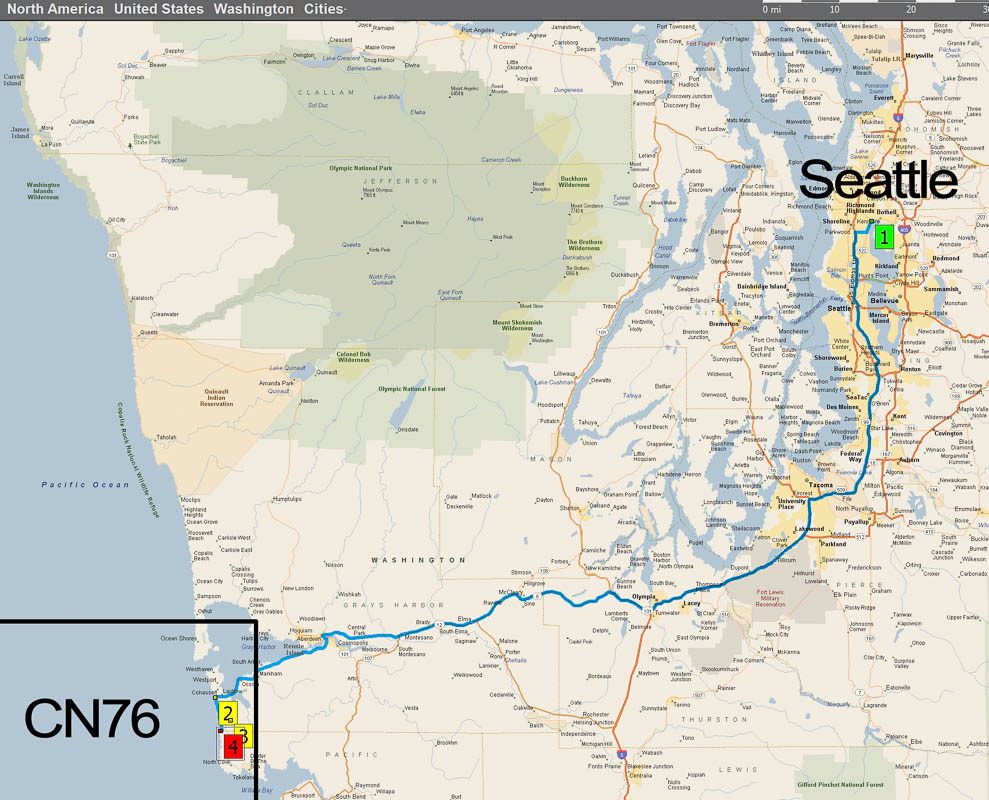
CN76 is a thin sliver of land on the west coast with extremely few good locations. However, I found a site that's wonderful - Grayland Beach State Park is a jewel of a Washington State campground. I've been boondocking to a lot of remote mountaintops so this trip was a real luxury to plug into RV shore power on a clean asphalt pad with fresh water and restrooms and showers.
Driving time from home to Grayland Beach via Aberdeen: 151 miles, 2 hr 50 min
I camped next to the sandy beach listening to the roar of the Pacific ocean while short scrubland trees sheltered me from the constant offshore wind. My site was a half mile from the water, which is far enough to be comfortably away from the hill to the east. My eastward horizon was reasonably low, only about 3 to 4 degrees.
In the photo below, taken from the water's edge, you can see the 1/2 mile of sand to the campground, and then the distant hill mounted with wind turbines.
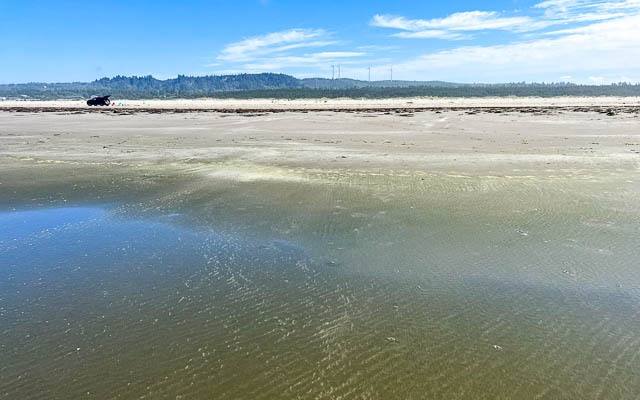
On the minus side, the campground has dense scrubby trees that prevented me from seeing the moon until after it rose above the angle I could still use it. My aiming had to be precise and magnetic compass readings are unreliable. So in the days before EME I took dozens of sun sightings to calibrate my compass rose.
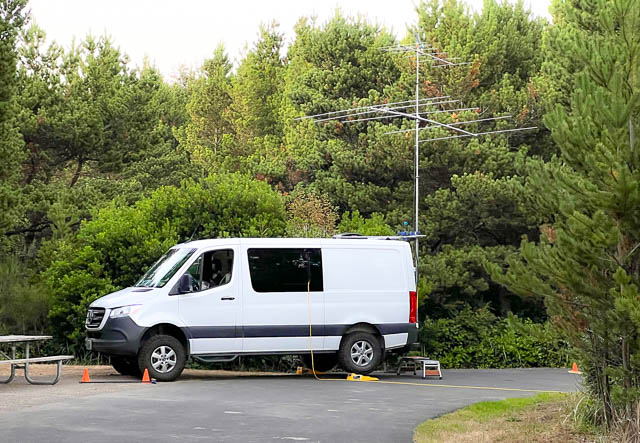
Carrying Antennas
The antennas are carried in mostly-assembled form. The 6m5 (six-meter five-element beam) and 2m7 (two-meter seven-element beam) can separate into convenient 4' boom sections.
The 6m5 fits neatly against driver's side interior wall. This is a lightweight assembly and all it needs is a single blue bungee cord to hold it in place.
The 2m7 separates into two sections. It's very lightweight and all it needs are rubber bands to hold it to some elements of the other antenna.
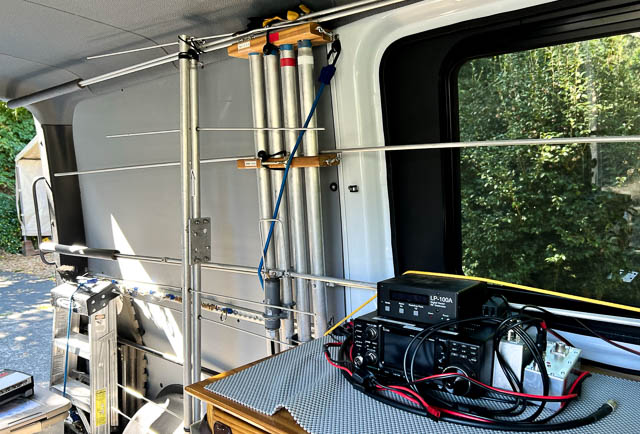
The Rover Van
I expected to have lots of free time on 6m due to DBS (Dead Band Syndrome), so I brought both my IC-7300 and IC-9700.
But I never actually end up with free time so this was wishful thinking. On this trip, I made time one morning to operate 2m for a couple folks that wanted CN76.

I use a telescoping aluminum tilt-up mast mounted on the hitch receiver. In the down position, it rests on a simple wooden tripod. Then, in the 'up' position, a small captured board (white) is clamped onto a wing above the van doors. This allows some adjustability to be made vertical.
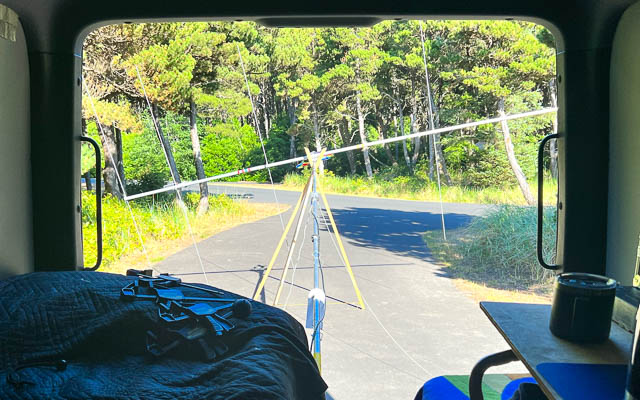
The latest addition to the mast is our Tuxedo Cat wind indicator. He pedals furiously to show the wind direction and speed. I put it up as a whimsical bit of color and then found it was incredibly valuable to know the conditions at the top of the mast.
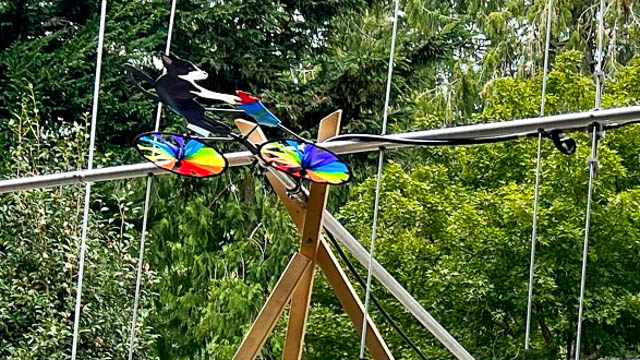
I often joke about spending the night in "Motel 5: Not Nearly As Swank and Luxurious as Motel 6!". So I photoshopped a fake vinyl logo onto a rear door.

Results
Ultimately, Murphy won again.
Propagation offered no openings, and I managed to work a few people in the nearest grids on groundwave and meteor scatter. Worse, my shiny new preamp failed during setup; it had a powerpole connection problem and somewhere during troubleshooting it popped a fuse and quit working. I had to run EME without it.
The first night, Lloyd and I never heard each other. Thankfully, when I could finally see the moon, my compass was spot on. On the second night, moon conditions improved, degradation was 2.4 and lower, and wow! Lloyd decoded my signals on most sequences for an hour and a half; I didn't hear him at all. No contact.
There are some happy folks who put CN76 in their log on 6m, and a couple more who got CN76 on 2 meters. All my contacts are in LotW.
I learned a great deal about moonbounce and Q65, and I'm happy to know my transmit chain is working well. And as for receive? Several new parts are on order to improve reception for our next attempt. Next time, I will have new coax, a new preamp, a spare preamp, a 48-volt LiFePO4 battery, and antenna upgrades. WSJT Echo Mode will test my lunar performance before I even leave the driveway.

We'll do better next time!
Thank you to everyone who chased me this trip, it was fun. And big thanks to John W9JN for all his help and expertise.
Barry K7BWH
PS - The definition of a "good game" is any activity which gives you a feeling of 'if I just try one more time I can do better.' Ham radio is a very good game.
| < Previous | Page 3 of 34 | Next > |
©1998-2024 Barry Hansen